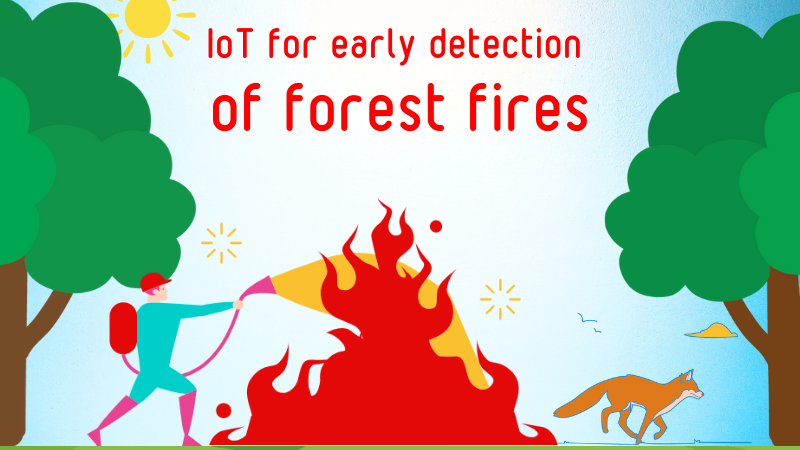Forest fires are increasingly threatening Georgia’s ecosystems, with reports from the Ministry of Environmental Protection and Agriculture highlighting the growing number of fire incidents. In 2022, wildfires affected 7,735 hectares, doubling the previous year’s area and causing devastating ecological damage. Georgia’s challenging terrain makes it difficult for firefighting teams to respond swiftly, necessitating early fire detection to minimize destruction.
Project Aim
The project aims to prevent forest fires using an innovative IoT-based early detection system. Installed across forest parks, the IoT sensors detect fire outbreaks and alert authorities and nearby individuals in real-time, sending coordinates to firefighting units for rapid response. This system leverages existing IoT infrastructure in Georgia and is adaptable to various regions depending on the density of sensors.
Key Objectives
1. Early Fire Detection: IoT sensors promptly notify authorities upon detecting a fire, enabling rapid response.
2. Fire Localization: Precise coordinates from the sensors allow for efficient fire localization, ensuring that multiple agencies receive accurate information in real time.
3. Data Collection and Prediction: The system collects environmental data such as temperature, humidity, and gas levels, providing valuable insights into fire risks and potential causes, enabling preventive measures.
Methodology
The methodology involves mapping fire-prone zones and installing IoT sensors to monitor environmental conditions. Data from the sensors is processed in real time, and any fire outbreak triggers immediate alerts. The system also supports long-term data analysis for predicting potential fire zones and causes, enabling proactive management. The project includes training for rangers, ensuring they can operate and maintain the system effectively.
The IoT sensors in this project collect various environmental data to detect and predict potential forest fires. These data include:
- Air Temperature: Two temperature readings are collected periodically. If the temperature exceeds a critical threshold, the system sends an alert to the server.
- CO Gas Levels: CO sensors measure carbon monoxide levels, sending periodic updates. If concentrations rise unexpectedly, the system triggers an immediate alert.
- Smoke Detection: Smoke detectors monitor air quality and send data if smoke is detected above normal levels.
- Air Humidity: Humidity levels are tracked throughout the day, with data being used to assess fire risk or identify potential fire causes. High humidity generally reduces fire risk, while low levels indicate dryness and increased fire danger.
- Battery Charge: Sensor battery levels are monitored, with daily updates sent to ensure the devices remain operational. If the battery falls below a critical level, it sends a warning.
These parameters help the system predict and respond to fire outbreaks by combining data trends and sensor alerts in real-time, enabling rapid decision-making.
Alerts in the IoT-based fire detection system are triggered through a combination of real-time sensor data monitoring and predefined thresholds for critical parameters. Here’s how it works:
- Temperature Spike: If the air temperature surpasses a critical threshold that indicates the potential for fire, an alert is immediately sent to the system server. This triggers an automatic warning to firefighting units and other relevant agencies.
- High CO Levels: When carbon monoxide (CO) levels rise above a safe threshold, indicating incomplete combustion or fire activity, the sensor sends an urgent data packet to the server. This packet is processed as an alert and dispatched to the appropriate authorities.
- Smoke Detection: Smoke detectors continuously monitor air quality, and if smoke particles exceed normal levels, a signal is sent to trigger an alert. The system flags this as a high-risk event and notifies responders immediately.
- Humidity Drop: Although humidity is typically tracked to assess fire risk, a sudden drop in humidity alongside temperature rise may trigger preemptive alerts, helping authorities predict possible fire hazards before they occur.
These alerts are sent via communication networks (internet, mobile, or proprietary networks) to local authorities, rangers, and firefighters, who receive the coordinates and status of the fire for quick response.
Community Involvement
An integral part of the project is raising public awareness and ensuring community participation. Informational campaigns will be conducted to educate locals on the importance of the system and their role in its upkeep.
Expected Outcomes
Within five months, the project will establish an autonomous early warning system, using various communication networks to transmit data. The system will be replicable across other forest parks and ensure long-term protection of Georgia’s forests from wildfires.
Users also ask these questions:
— How does IoT enhance fire detection in remote areas?
— What are the key challenges in implementing IoT for wildfire prevention?
— How does community involvement improve the effectiveness of fire detection systems?


